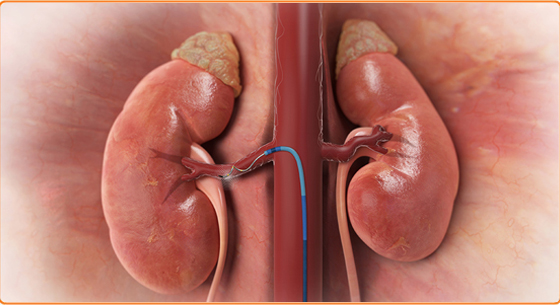Resistant hypertension refers to high blood pressure which has not responded to medication. Renal denervation (RDN) is a minimally invasive procedure to treat resistant hypertension. The procedure uses radiofrequency ablation to burn the nerves in the renal arteries. This process causes a reduction in the nerve activity, which decreases blood pressure.
You will have a local anaesthetic for the procedure and it will be carried out under image guidance.

The interventional radiologist will insert a catheter into the femoral artery in your thigh, and through this will access the arteries feeding your kidneys. During the RDN procedure, radiofrequency pulses are applied, burning the nerves in the walls of the renal arteries.
The aim of the procedure is to burn the renal nerves without damaging the arteries. Each application of radiofrequency ablation will last for around 1-2 minutes, though this depends on the device used. The interventional radiologist may use a catheter (tube) radiofrequency generator, which requires more than one application of the radiofrequency pulse during the session, or a radiofrequency balloon generator, which requires a single application of radiofrequency pulse.
This procedure is designed for patients who suffer from resistant hypertension, i.e. those who have already unsuccessfully tried a regimen of at least three medications to treat hypertension at the same time.
In order to be suitable for this procedure, you will need to have strong and healthy veins.
As RDN is a relatively new procedure, little is known about its long-term effects. However, it has been shown to be an effective treatment for resistant hypertension.
There are a number of risks associated with the procedure. Some patients experience bradycardia (slow heart rate) during the procedure. If this happens, you will be given atropine.
The radiofrequency ablation may cause changes to the wall of the arteries, which can sometimes lead to renal artery stenosis (the narrowing of the renal arteries).
The imaging used during the procedure also has a number of risks. Bruising can occur to the punctured site at the top of the thigh. Other possible complications include pseudoaneurysm (a bruise caused by a leaking hole in an artery) and tearing in the renal arteries.
